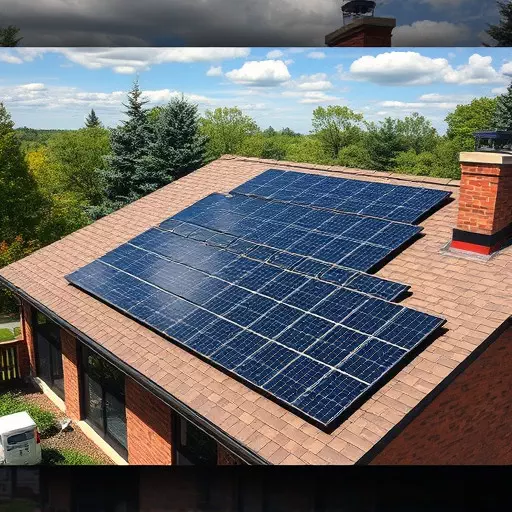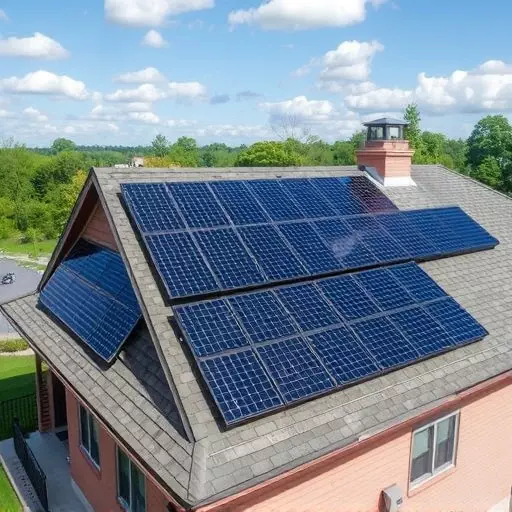In Appleton, Wisconsin, where severe weather events are common, understanding wind load requirements for solar roofing systems is vital. Local building codes incorporate wind load calculations to ensure installations can withstand high-velocity winds and debris. Integrating photovoltaic (PV) panels requires robust mounting systems, secure fastening techniques, and strategic panel layout to minimize damage. Prioritizing structural integrity using wind-resistant materials, hardware, and adherence to local standards ensures system resilience against strong winds, providing a safe and durable solar roofing solution.
In the heart of Wisconsin, Appleton faces unique challenges when it comes to renewable energy solutions, particularly with wind load considerations for solar roofing systems. This article delves into the critical aspects of designing and installing solar roofing systems in this dynamic environment. We explore understanding specific wind load requirements, seamlessly integrating photovoltaic panels, and upholding structural integrity to ensure robust, wind-resistant solar installations. By focusing on these key areas, Appleton residents can harness the power of solar energy with confidence, leveraging its benefits for years to come.
- Understanding Wind Load Requirements for Solar Roofing Systems in Appleton, Wisconsin
- Integrating Photovoltaic Panels: Design and Installation Considerations
- Ensuring Structural Integrity: Best Practices for Wind-Resistant Solar Installations
Understanding Wind Load Requirements for Solar Roofing Systems in Appleton, Wisconsin
In Appleton, Wisconsin, understanding wind load requirements is paramount when considering the installation of solar roofing systems. With frequent and potentially severe weather events, ensuring that photovoltaic (PV) panels and the overall roof structure can withstand high winds is essential for safety and system longevity. The wind load on a solar roofing system—the force exerted by wind against the panels—needs to be carefully evaluated as it can vary significantly depending on factors like local wind patterns, roof slope, and panel orientation.
Appleton’s location makes it susceptible to powerful storms and high-velocity winds, which can lead to significant stress on solar installations. Therefore, when designing or installing a solar roofing system in this area, engineers and installers must adhere to specific building codes and standards set by local authorities. These guidelines often incorporate wind load calculations to guarantee that the structure can resist potential damage from airborne debris during intense weather conditions.
Integrating Photovoltaic Panels: Design and Installation Considerations
When integrating photovoltaic (PV) panels into a structure, especially in the context of solar roofing systems Appleton Wisconsin, careful design and installation considerations are paramount. The roof, being a key component of any solar roofing system, must be able to withstand not only standard structural loads but also additional wind loads generated during storms or high-speed winds. Therefore, robust mounting systems that align with industry standards and local building codes are essential to ensure the safety and longevity of both the solar panels and the roof itself.
During installation, it’s crucial to account for proper fastening techniques, ensuring panels are securely fastened without compromising the integrity of the roofing materials. Additionally, the layout and orientation of PV panels should consider the prevailing wind direction to minimize potential damage from wind forces. These considerations, when thoughtfully incorporated into the design phase, help maximize the efficiency of solar roofing systems while upholding the structural stability of the building.
Ensuring Structural Integrity: Best Practices for Wind-Resistant Solar Installations
When installing solar roofing systems in Appleton, Wisconsin or any other location prone to strong winds, ensuring structural integrity is paramount. Best practices involve utilizing wind-resistant materials and designs specifically tailored for such conditions. For instance, photovoltaic (PV) panels should be securely fastened with robust mounting hardware that can withstand high winds without compromising the panel’s integrity.
Additionally, solar installations should adhere to local building codes and engineering standards set for wind load considerations. Regular inspections and maintenance are crucial to identify and rectify any potential weaknesses in the system, enhancing its overall resilience against strong winds and ensuring a safe, durable solar roofing solution.


